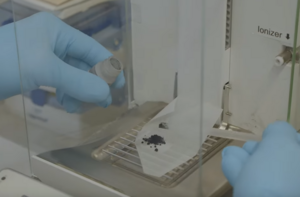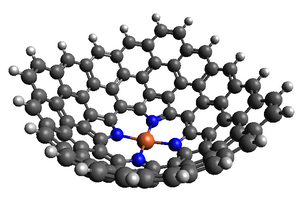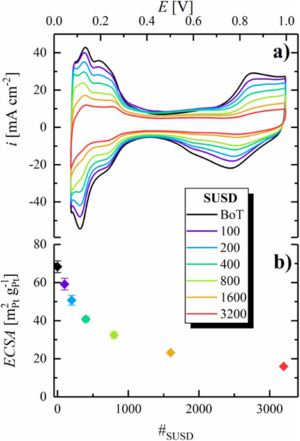Catalyst Synthesis & Catalyst Layer Design

At the atomic level, fuel cells rely on supported catalysts based on platinum group metals (PGM) to minimize the overpotentials associated with oxygen reduction reaction (ORR) and hydrogen oxidation reaction (HOR). Activity and stability of these systems can be tuned by tailoring their electronic and morphological structure in synthesis. At the device level, integration of these novel materials requires a catalyst layer fabrication process optimized for efficient mass transport in the three-dimensional microstructure.
Our interests:
- Synthesis and characterization of PGM-based catalysts and catalyst alloys
- Modification of support morphology and surface properties
- Multi-objective optimization of electrode microstructure and transport properties
Recent publications:
- HOR Activity of Pt-TiO2-Y at Unconventionally High Potentials Explained: The Influence of SMSI on the Electrochemical Behavior of Pt / Geppert, T. N.; Bosund, M.; Putkonen, M.; Stühmeier, B. M.; Pasanen, A. T.; Heikkilä, P.; Gasteiger, H. A.; El-Sayed, H. A. / J. Electrochem. Soc., 2020, 167, article # 084517 (Open Access) - DOI
- Tailoring Catalyst Morphology towards High Performance for Low Pt Loaded PEMFC Cathodes / Harzer, G. S. ; Orfanidi, A. ; El-Sayed, H. ; Madkikar, P. ; Gasteiger, H. A. / J. Electrochem. Soc., 2018, 165(19), F770-F779 (Open Access) - DOI
Pt-free Catalysts

The high cost and the restricted availability of Pt and other critical raw materials (CRM) used in current catalysts is one of the major hurdles for the large-scale commercialization of Proton Exchange Membrane Fuel Cells (PEMFCs). Our research deals with finding appropriate and inexpensive alternatives to CRM in terms of activity and stability, with a major focus on catalyst layer design and testing, both for commercially-available and home-made catalysts.
Our interests:
- Novel Pt-free catalyst developing
- In-situ quantification and mechanistic study of active site for Pt-free catalyst
- Catalyst layer design and characterization in PEMFC
Resent publications:
- Active‐Site Imprinting: Preparation of Fe–N–C Catalysts from Zinc Ion–Templated Ionothermal Nitrogen‐Doped Carbons / Menga, D., Ruiz‐Zepeda, F., Moriau, L., Šala, M., Wagner, F., Koyutürk, B. Bele, M., Petek, U, Hodnik, N. Gaberšček, M., Fellinger, T. P. / Advanced Energy Materials 9.43 (2019): 1902412 - DOI
- Probing Transition-Metal Silicides as PGM-Free Catalysts for Hydrogen Oxidation and Evolution in Acidic Medium / Mittermeier, T. ; Madkikar, P. ; Wang, X. ; Gasteiger, H. A. ; Piana, M. / Materials, 2017, 10 (6), 661 - DOI
- Synergistic Effect on the Activity of ZrO2-Fe as PGM-Free ORR Catalysts for PEMFCs / Madkikar, P. ; Mittermeier, T. ; Gasteiger, H. A. ; Piana, M. / J. Electrochem. Soc., 2017, 164 (7), F831 - F833 (Open Access) - DOI
Polymer Electrolyte Membrane Fuel Cells (PEM FC) Durability and Diagnostics

PEM FCs must meet defined lifetime expectations to increase their appeal for transportation applications. This key performance factor (namely, durability) points out the need of understanding degradation mechanisms intrinsic to the operation of a PEM FC. One crucial part of our job at Technical Electrochemistry is the application of accelerated stress tests (ASTs) to trigger degradation in laboratory scale setups, followed up by the assessment of the targeted component status by in situ and ex situ diagnostic tools, leading to a final correlation between the observed degradation and performance loss.
Our interests:
- Testing of aging protocols for localized component degradation (catalyst layer, proton-exchange-membrane and bipolar plates)
- Utilization of in situ and ex situ diagnostic tools to correlate degradation to performance losses in PEM FCs
- Catalyst degradation under transient operations e.g. start-up and shutdown cycles (SUSD).
- Membrane state-of-health after wet / dry cycles.
- Effect of high oxygen permeable (HOP) ionomers on mass transport limitations during high current operation.
- Morphological changes in the MEA (membrane electrode assembly) via SEM imaging.
Recent publications:
- PEM Fuel Cell Start-Up/Shut-Down Losses vs Relative Humidity: The Impact of Water in the Electrode Layer on Carbon Corrosion / Mittermeier, T.; Weiß, A.; Hasché, F.; Gasteiger, H. A. / J. Electrochem. Soc., 2018, 165(16), F1349-F1357 (Open Access) - DOI
- Anode Aging During PEMFC Start-Up and Shut-Down: H2-Air Fronts vs Voltage Cycles / Schwämmlein, J. N.; Rheinländer, P. J.; Chen, Y.; Freyer, K. T.; Gasteiger, H. A. / J. Electrochem. Soc., 2018, 165, F1312-F132 (Open Access) - DOI
- Activity and Stability of Carbon Supported PtxY Alloys for the ORR Determined by RDE and Single-Cell PEMFC Measurements / Schwämmlein, J. N.; Harzer, G. S.; Pfändner, P.; Blankenship, A.; El-Sayed, H. A.; Gasteiger, H. A. / J. Electrochem. Soc., 2018, 165(15), J3173-J3185 (Open Access) - DOI
- Cathode Loading Impact on Voltage Cycling Induced PEMFC Degradation: A Voltage Loss Analysis / Harzer, G. S.; Schwämmlein, J. N. ; Damjanovic A. M. ; Gasteiger, H. A. / J. Electrochem. Soc., 2018, 165 (6), F3118-F3131 (Open Access) - DOI
Gas Diffusion Layers
The role of the gas diffusion layer (GDL) is to homogeneously distribute reactant gases over the electrode surface, to efficiently remove product water, and to provide good electrical and thermal contact. At TEC, we are investigating the complex transport processes and optimizing the properties with regard to high current density operation.
Our interests:
- Preparation and characterization of innovative microporous layer (MPL) coatings
- Determination of effective mass transport properties by limiting current approach in differential single cell
- Development of novel GDL/MPL characterization techniques
Resent publications:
- Interaction of Pore Size and Hydrophobicity/Hydrophilicity for Improved Oxygen and Water Transport through Microporous Layers / Simon C.; Endres J.; Nefzger-Loders B.; Wilhelm, F.; Gasteiger, H. A. / J. Electrochem. Soc., 2019, 166 (13), F1022-F1035 (Open Access) - DOI